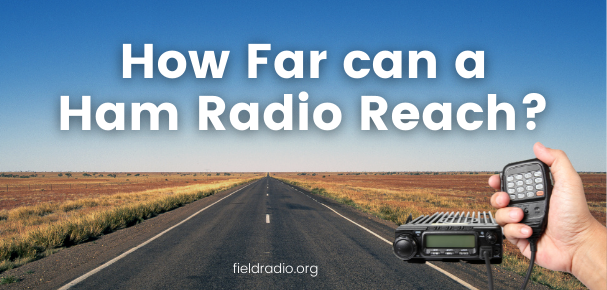Choosing the best Ham radio frequencies to listen to is a critical part of your entire Amateur radio experience.
The diversity of all that is happening on the Ham bands is insane. And if you are not careful with your frequency selection, you can end up being slightly underwhelmed with the results.
But finding the right ham radio frequency and answering the question “What ham radio frequencies to listen to?” is not as straightforward as it may seem.
Therefore, I have dedicated an entire article to answering this question.
In this article, I’ll discuss what amateur frequencies you should listen to based on your interests. And if you read till the end, you’ll find a simple and insightful way of finding these frequencies to program in your device.
What Ham Radio Frequencies should I Listen to?
The Ham radio world is diverse. From fun chitchat, friendly banter, and local gossip to technical radio information and life-critical reports, the possibilities of what you can listen to with a Ham radio are wide.
Ham radio serves a variety of purposes. So, a lot is going on in the Ham radio world.
Here’s what you can expect to listen to with a Ham radio:
The Geeky Technical Stuff
Most of the time, Hams go on air to talk about their hobby. They share the tech specs of their “toys” with other Hams, and the conversation kicks off from there.
You can listen to this conversation to learn more about the different aspects of the Ham radio hobby.
Casual Chitchat
Apart from the technical stuff, Ham radio operators also have certain rag chew frequencies, where they share local gossip and small talk.
You can tune into these frequencies to listen to your local hams share your area’s news and updates, learn about their doctor’s appointments – believe me, that’s one of the topics – and listen to them lambasting the neighborhood kids.
Ham Nets
Ham radio operators also arrange “on-air” gatherings called nets. These are regular programs where other hams discuss a topic of interest, which is mostly related to the hobby. Tuning into one of these nets can help you learn a lot about the hobby and how to get the most out of it.
Critical Weather Updates
There are certain emergency frequencies for Ham radio where you can also listen to weather updates and warnings.
The NOAA uses dedicated radio frequencies for disseminating weather-related information. This especially comes in handy during natural disasters when modern communications are out and knowing live weather updates becomes critical for survival.
What you can listen to on a ham radio eventually boils down to what frequency you tune in to, which is why it is so important to know what Ham radio frequencies to listen to.
Ham Radio Frequencies to Monitor –
Important Ham Radio Frequencies to Listen to
You already know that it is impossible to have a straightforward answer to the question “What Ham radio frequencies to listen to?”
Now, I’ll tell you why.
It’s because the chitchat, technical discussion, and emergency alert frequencies vary from locality to locality.
For example, SKYWARN net frequency in Indiana, Pennsylvania, is 146.91 MHz, while for Brooke West Virginia, it is 146.94 MHz.
That is why, we cannot have a generic list of the “right” Ham radio frequencies that everyone can listen to.
Moving on. Let’s talk about what frequencies you should listen to, based on your interests.
Emergency Frequencies
Most people use the Ham radio to stay connected during emergencies. If that’s you, I would recommend listening to the NOAA and National Weather Service frequencies.
The NOAA has seven frequencies through which they broadcast news, updates, forecasts, and weather-related information 24-hours a day. Even though these frequencies fall out of the Amateur 2m band, your radio might be able to pick them up because most Amateur radios can receive out-of-band frequencies. And there’s no legal restriction around picking up out of band signals, as long as the information you are receiving is intended for the general public.
The National Weather Service, on the other hand, has a dedicated network of Amateur radio operators under their SKYWARN program. These hams work with NWS and share weather emergencies, warnings, and updates on Ham radio frequencies.
The SKYWARN uses different frequencies in different states. You can find out the relevant frequencies from National Weather Service’s website.
Now, let’s talk about frequencies that can get you in the loop of your local ham radio community.
Community Frequencies
If you want to join the Ham radio community, you will have to look for and listen to the frequencies where Hams get together – Ham nets – so that you can edge your way in.
Like weather frequencies, the Ham net frequencies also vary from state to state. For example, according to the ARRL Ham net’s directory, there’s a Bartlesville, Oklahoma rag chew net that operates on 444.775 MHz on Wednesdays at 8:30 pm. In comparison, there’s a morning Ohio rag chew net that operates on 28.337 MHz, Monday-Friday at 8:30 am.
If you want to connect with your local hams, socialize, or get updates about the local news and gossip, you can find one of these rag chew nets in your state and tune into them.
However, if you are looking to join in on some serious conversation or want to participate in an emergency preparation drills, there are ARES and SKYWARN nets that you can listen to.
For example, the Creek County ARES Oklahoma net is active on Saturdays at 7 pm at 145.430 MHz.
You can find such nets in your own locality and join them when they are active.
Before we proceed, let me reiterate that if you don’t have a Ham radio license, please only listen. Listening to a Ham radio without a license is fine. But do not transmit, as unlicensed transmission can get you in some serious trouble.
Now, let’s finally talk about how you can find these frequencies.
How To Find Ham Radio Frequencies Near Me?
So far, we have discussed all the frequencies or categories of Ham radio frequencies you can listen to. And I have also told you how frequencies vary depending on where you live.
Now I’ll tell you how you can find the right frequencies in your area.
One way to find interesting frequencies is to reach out to your local Ham club and ask them directly.
You can reach out to a local friendly ham and ask them about the frequencies they use for weekly programs, chitchat, and weather emergencies.
But if you dislike in-person communication and would rather discover frequencies in a way that requires no human contact, let me tell you another method of finding frequencies.
Radioreference.com has one of the largest databases of Amateur radio frequencies and their intended use. You can log on to www.radioreference.com, type in your area’s zip code or state’s name, and retrieve the database.
You will have to click on the Amateur Radio tab at the top of the page to get to the Ham radio frequency’s directory.
From there, you can find out and program whatever Ham radio frequencies you want to listen to.
As far as Ham radio nets are concerned, ARRL has an extensive database of all registered Ham radio nets on their website. You can visit www.arrl.org/arrl-net-directory-search and search for your required net easily.
It’s also worth noting that, as you have the ability to tune into any frequency with your gear, you could even listen in to CB or GMRS frequencies with your ham radio.
Final Word
When you jump into the Ham radio world, it’s usually with a purpose.
You either want to practice it as a hobby or rely on the communication medium to keep you connected during emergencies.
The purpose you use your Ham radio for can largely define the right Ham radio frequencies to listen to for you.
If you want to stay in the loop on local gossip and chitchat, your locality’s rag chew frequency might help. For more serious, regular conversations, you can tap into one of your area’s amateur radio nets. And to stay updated on the weather situation in emergencies, you can find, program, and listen to the NOAA and SKYWARN frequencies, as discussed above.
Finding these frequencies is no biggie either. Follow the procedure I outlined above, and you’ll find the right Ham radio frequencies to listen to in no time.
There. Now you have the answer to your question “What Ham Radio Frequencies to Listen to?” It wasn’t that simple now, was it?

I have been passionate about the world of communications in its various forms for most of my life. Ever since I first found an old ham radio stashed away in my uncle’s attic, I have had a fascination with this classic technology.
Having the ability to communicate with people without the need to rely on telephone lines or networks is an empowering feeling which I believe everyone should have at least a basic knowledge of. Becuase who knows when you might need it?
I setup fieldradio.org with this passion in mind, to help inform people about the amazing possibilities of amateur radio and I’m on a quest to help educate as many budding operators as possible.
I hope you enjoy our content. Come and say hi, via our contact form


